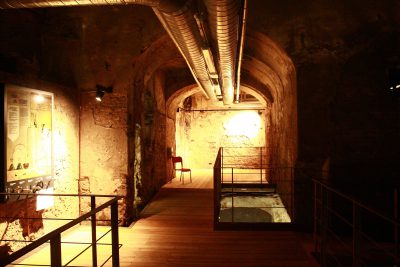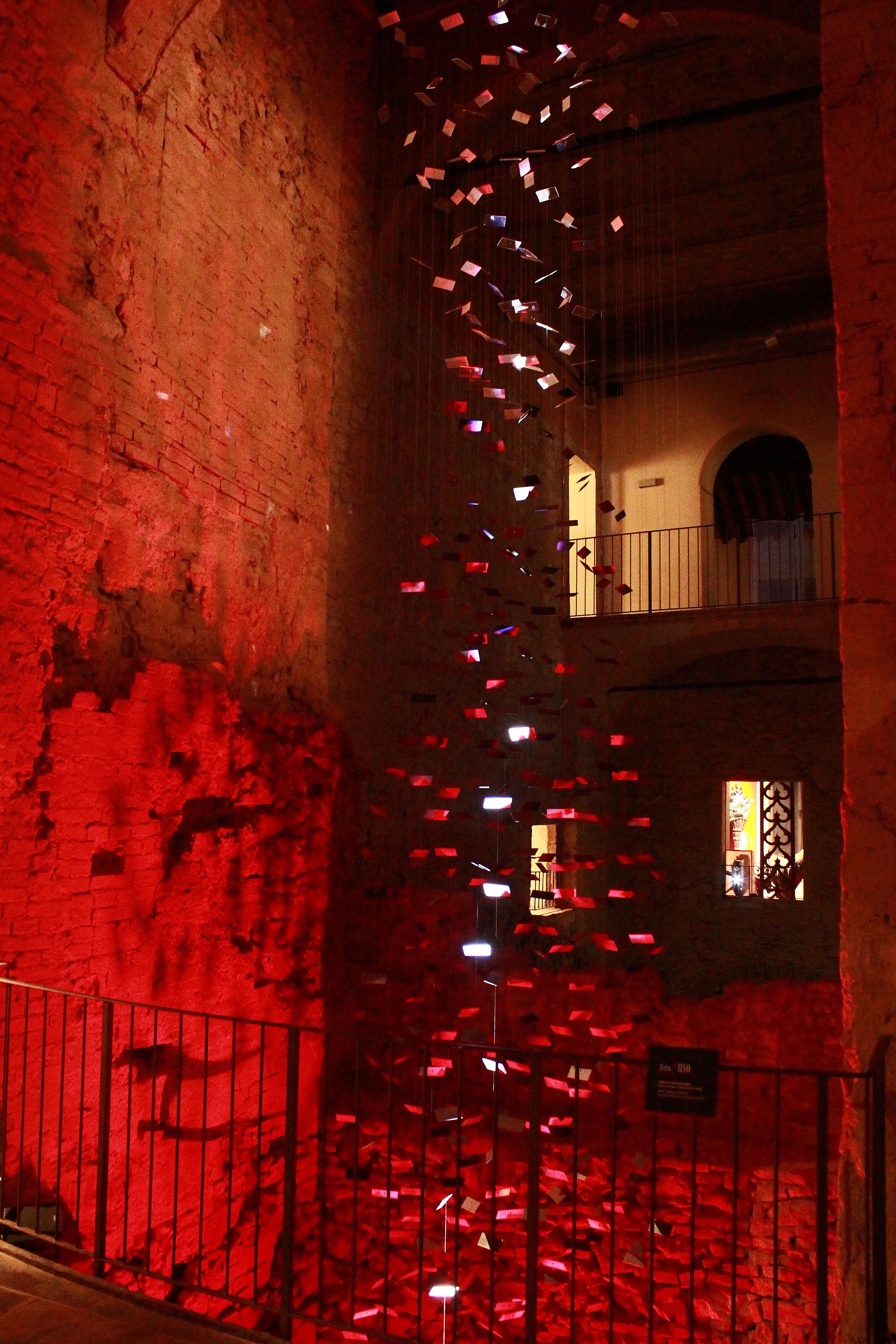The Museum of cast iron arts in the Maremma (MAGMA) is a museum located in Follonica, in the area of the former Ilva foundries of Follonica.
History
Since the closure of the Ilva industrial plant on 22 February 1960, the need was felt among the population of a city born and raised with iron and steel production, to create a museum that testified to the city’s flourishing tradition. Initially, a first museum on the history of workers and the art of cast iron was inaugurated in a temporary location in 1970, and subsequently, in 1998, with the restoration of the ancient San Ferdinando oven, the new Museum of iron and cast iron was born . The museum was completely renovated and modernized in 2013 with the setting up of MAGMA, the Cast Iron Museum of Arts in the Maremma, based on a project by architects Barbara Catalani and Marco Del Francia, created by Asteria with the advice of the historian Tiziano Arrigoni and Claudio Casini and Maria Pizzetti. MAGMA was inaugurated on June 29, 2013 and opened to the public on July 9 of the same year.
Building
The MAGMA is set up inside the San Ferdinando oven, the oldest building in the Ilva plant. The original nucleus probably dates back to the 15th century and had the function of a mill; in 1546 it was enlarged with the construction of an ironworks, then dismantled in the early 19th century with the construction of a smelting furnace: a small square furnace, abandoned in a few years and renovated in 1818 with a modern round furnace dedicated to San Ferdinando. The oven was considered one of the most modern in Italy, first in Tuscany. The building was enlarged to also include some dormitories for the workers, warehouses, bunkers and shops. Remained in use until 1888, it was dismantled in the years following 1907. Restored in the nineties of the twentieth century, it has become a museum site – the then Museum of iron and cast iron – since 1998.
Exhibition Halls
First floor
The exhibition itinerary begins on the first floor of the building, dedicated to art in iron and cast iron, the maximum specialized production of the Follonica foundries. At the entrance, one encounters the large space of the blast furnace, restored and enriched by an installation which, located in the place where the smelting furnace with the chimney for the smoke was once located, attempts to reproduce it in a poetic way. It is a cascade of metal blades arranged in such a way as to recreate the original dimensions of the oven and made of different materials to recall the various stages of loading: the red blades at the bottom recall the ignition phase; the metal ones in the center allude to the mineral thrown together with the coal inside the oven; finally, the transparent blades placed higher up recall the smoke, which, coming out of the chimney, rose towards the sky. The walls of the blast furnace are also the protagonists of a multimedia show projected at regular intervals which sees the visitor virtually transported within the smelting process: on the walls first the images of the shadows of the workers at work stand out, then a casting of red-hot iron it seems to fill the walls, which become incandescent, begin to crack and leave room for forged material, monumental cast iron decorations, and then conclude with the sea of Follonica, the modern city.

A “magmatic temple” has been set up next to the oven: in the center is a large sample of hematite.
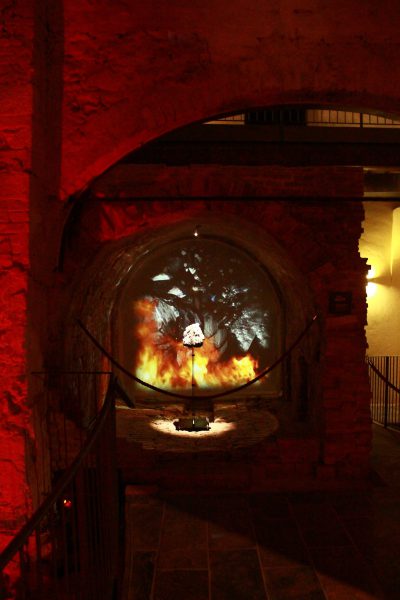
The first room contains a vast collection of wooden models which served to imprint the shape in the earth in which to pour the molten iron, to give life to decorations, sculptures, but also real and its monuments in iron and cast iron for a refined street furniture.
Inside the room, however, an ancient wooden work table stands out, donated by the Franchi Giuggioli family, accompanied by a rich collection of original work tools, used by the model maker, the trainer and the smelter. There are a protractor for measuring angles; a chisel; a gouge, a chisel-like tool used to create curved surfaces; there is the spaccacentro, useful for finding the center of the wood; a spatula, to fill the chipped parts of the model; a bank for the angles; a set of tools for sharpening or bending saw teeth are on display; a twist drill bit, for drilling wood cutting; a mallet for beating chisels; punches; the clamp to stop the wood; the whetstone for sharpening tools; the crosses, for the formal finishing touches; a set of screw eyebolts, to extract the smaller size models from the mould; there are the truelle, the esse and the spattrugli to smooth and finish the stirrups; the spoons; the lights, to refine the corners of the shape; there is the pin, to aerate the casting during casting; finally the brackets and the brushes. Furthermore, a projector brings that art back to life with a projection onto the work table: the hands of Giuliano Zacchini, a true model maker in the days of the foundries.
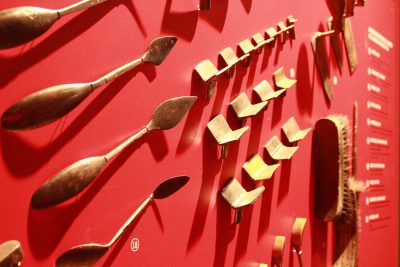
The second room allows the visitor to continue the journey through the art of iron, with decorative details such as wooden models of motifs for fountains, animal heads (Egyptian cat, ox, lions, rams), three cast iron and wooden balcony railing brackets, two wooden door rosettes and a cast iron pierced panel. The large model of a ram’s head, a decoration now lost for the gate of the Medicean farm of Tavola, near Prato, is interesting. The particularity and refinement of these ornaments was such that the need was felt to draw up a catalog containing all the furnishings produced by the foundries: thus the Catalog of Castings was born, printed by the Corradino Mori typography of Follonica in 1913. An interactive panel allows the visitor to browse the entire catalogue.
The third room is divided into two sections, both dedicated to the two main artistic works in cast iron of Follonica, which in some way inaugurated the great decorative tradition of the establishment, and consequently to the two designers who created them conceived: they are the church of San Leopoldo and the Magonale Gate, both designed by the architects Alessandro Manetti and Carlo Reishammer.
The first section displays some wooden models of decorations from the church of San Leopoldo. There are some coats of arms and trophies with ecclesiastical symbols; decorated with plant motifs; an altar aedicule.
The second section, which illustrates the history of the monumental cast iron gate of the establishment, exhibits the models of those ornaments such as the great cornucopias and flaming torches. The art of iron made the industries of Follonica known in the rest of Italy and the first commissions for urban furnishings began.
Before the end of the visit to the first floor, a room allows you to see the reconstruction of the large water wheel that operated the blower machine that pumped the air into the oven of San Ferdinando. Built in 1818 in Sebastiano Gelli’s carpentry shop, the wheel was made to move by the water coming from the bottaccio, a masonry tank that collected the water coming from the metalliferous hills of Massa Marittima through the artificial canal of the Gora delle Ferriere.
Second floor
The second floor of the building is entirely dedicated to illustrating the history of that metallurgical tradition which made Follonica one of the leading industrial realities in Italy in the 19th century. The five rooms that make up this section allow for historical insights ranging from the Etruscan period to contemporary Follonica. In addition to the exhibition halls, there is the so-called hall of ghosts, where archival films of Follonica from all times are projected, retrieved from television news, cultural institutes, RAI, associations and individuals; a video room for the projection of informative films; and finally educational workshops to give school groups the concrete possibility of studying and applying themselves to wood carving, modeling and tin casting.
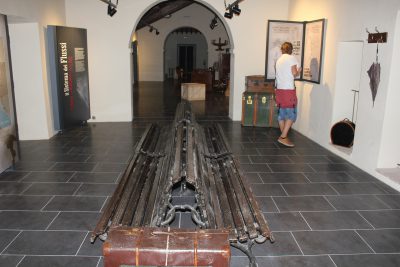
Basement floor
The visit ends in the basement with a long walkway that leads towards the center of the San Ferdinando oven, where the restoration has brought to light lost spaces such as the old bunker and the mouth of the oven. At an auditory level, the visit is enriched by the sounds and noises of work in the foundries, while at a visual level, films of the workings of a modern foundry are projected on the walls. The visitor can also see again, this time from below, on the side of the landing stage, the large water wheel with the blowing machine.
Two interactive installations conclude the visit. The first is the so-called fusion game: the visitor selects the right amount of iron ore, coal and additive mixture, then adds it to the right volume of hot air to blow, and once done the oven a voice will say if the fusion was successful in the right way or not. The second instead allows you to select one of the last generation workers on a screen, before the foundry was closed in February 1960.
